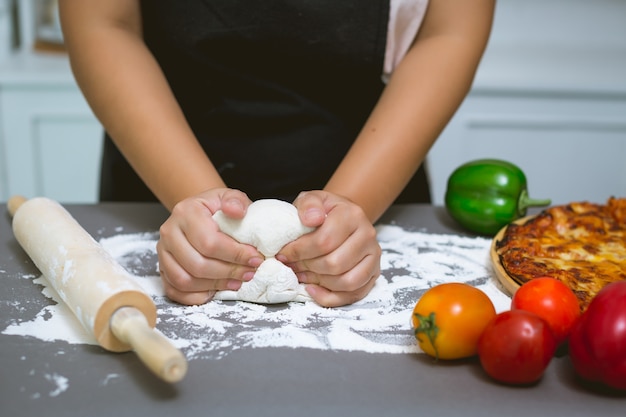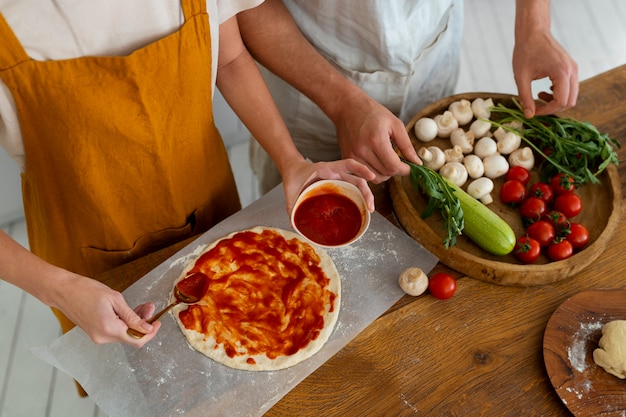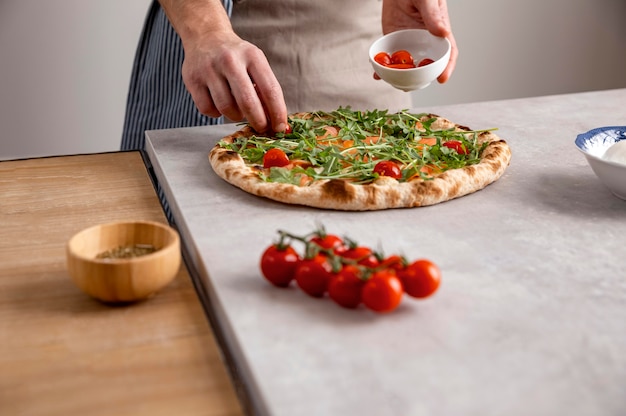As a self-proclaimed pizza enthusiast, I've spent countless hours perfecting the art of making pizzas at home. It's a labour of love, from crafting the dough to selecting the perfect toppings. But one question that always pops up is: how long do you cook it for? It's not as simple as a set timer, and trust me, I've made my fair share of mistakes in the pizza oven.
This article is going to dive into the world of pizza baking, exploring the key factors that influence cooking time and providing practical tips to help you achieve that golden-brown, bubbly perfection. So grab a slice of your favourite pizza (or a glass of wine, if you're like me!), and let's get started.
Part 1: The Importance of Oven Temperature

Why Temperature Matters
The oven temperature is the single most important factor determining how long you need to cook your pizza. Think of it like this: a scorching hot oven creates a crispy crust in a short amount of time, while a cooler oven will result in a doughy, soggy mess. Ideally, you want your oven at a roaring 475–500°F (246–260°C) for that perfect pizza.
The Science Behind High Heat
Why such a high temperature? High heat allows the dough to cook quickly, creating a crispy crust without drying out the interior. The intense heat also helps the toppings cook evenly and develop a beautiful golden-brown colour.
My Personal Experience
I used to think a regular oven would suffice, but I was wrong! I once tried to bake a pizza in a conventional oven at 400°F, and let me tell you, it was a disaster. The crust remained pale and undercooked, while the toppings were practically raw. It was a true pizza tragedy!
The Pizza Stone Solution
The solution? A pizza stone! This magical slab of rock absorbs heat and distributes it evenly, creating a truly pizza-perfect environment. It also helps the crust develop a nice, crispy texture. The stone's heat retention ensures that the bottom of the pizza cooks evenly, preventing a soggy crust.
I remember the first time I used a pizza stone. The difference was night and day. The crust was crisp, the cheese was perfectly melted, and the toppings were cooked to perfection. It was a revelation!
Part 2: Mastering the Dough

The Foundation of a Great Pizza
The dough is the foundation of a great pizza. It's what holds everything together and adds that satisfying chewiness. A well-made dough will be light, airy, and slightly elastic, allowing it to stretch out nicely without tearing.
The Importance of Gluten Development
The key to a good pizza dough is gluten development. Gluten is a protein found in wheat that gives dough its structure and elasticity. When you knead the dough, you're essentially developing the gluten strands, making the dough stronger and more pliable.
My Go-To Dough Recipe
Here's my favourite dough recipe that I swear by. It's simple, forgiving, and always yields delicious results.
- 2 cups (250g) all-purpose flour
- 1 teaspoon (5g) active dry yeast
- 1 teaspoon (5g) sugar
- 1 teaspoon (5g) salt
- 1 cup (240ml) warm water
- 1 tablespoon (15ml) olive oil
This recipe is a classic for a reason. It's a good balance of ingredients that create a dough that's both flavorful and easy to work with.
The Kneading Process
Once you've mixed the ingredients, knead the dough for about 5-10 minutes until it's smooth and elastic. Kneading helps develop the gluten strands, giving the dough its texture. Don't be afraid to get your hands dirty!
You'll know the dough is properly kneaded when it's smooth, slightly tacky, and springs back when you poke it.
Rising to the Occasion
After kneading, let the dough rise in a warm place for about 1 hour, or until it has doubled in size. This allows the yeast to work its magic, making the dough light and airy.
The best way to ensure your dough rises properly is to create a warm, humid environment. You can achieve this by placing the dough in a bowl, covering it with a damp tea towel, and putting it in a warm spot in your kitchen.
Part 3: Stretching and Shaping

Stretching the Dough
Once the dough has risen, it's time to stretch it out into a pizza base. You can use your hands, a rolling pin, or a combination of both. If using your hands, gently press the dough into a round shape, working from the centre outwards.
For a more even shape, you can use a rolling pin to gently roll out the dough, being careful not to overwork it.
Don't Be Afraid of Thin Crust
For a classic Neapolitan-style pizza, aim for a thin, almost translucent crust. If you're new to pizza making, don't worry about getting the perfect shape. It's all about practice! The key is to stretch the dough as thin as possible without tearing it.
The Secret to a Perfect Crust
To prevent the dough from shrinking back, make sure the surface where you're stretching it is lightly dusted with flour. This helps to reduce sticking.
You can also use a pizza peel to help you stretch and transfer the dough to the hot pizza stone. A pizza peel is a long-handled wooden or metal paddle that makes it easy to slide the pizza in and out of the oven.
Part 4: The Art of Toppings
The Less is More Approach
When it comes to toppings, I'm a firm believer in the "less is more" philosophy. Too many toppings can overwhelm the flavour of the crust and make the pizza soggy.
A good pizza should have a balance of flavours and textures, and the toppings should complement the crust, not overpower it.
My Favourite Toppings
Some of my go-to toppings include:
- Tomato sauce
- Mozzarella cheese
- Fresh basil
- Pepperoni
- Mushrooms
- Onions
These are just a few examples, and you can experiment with different toppings to create your own signature pizzas.
The Importance of Freshness
I always use fresh, high-quality ingredients whenever possible. Fresh herbs and vegetables add a burst of flavour that can't be replicated with canned or processed alternatives.
For example, fresh basil leaves have a bright, aromatic flavour that's essential for a classic Margherita pizza.
Part 5: Preheating the Oven
The Importance of Patience
Before you even think about putting your pizza in the oven, make sure it's preheated to that scorching hot temperature we talked about earlier. It's crucial to allow the oven to reach the desired temperature for at least 30 minutes.
Preheating the oven allows the pizza stone to reach the optimal temperature, ensuring that the pizza cooks evenly and develops a crispy crust.
The Trick to Even Heat Distribution
To ensure even heat distribution, place a pizza stone in the oven while it's preheating. This helps the stone absorb the heat and create a consistent baking environment.
The pizza stone acts like a heat sink, absorbing the heat from the oven and transferring it to the pizza. This ensures that the pizza cooks evenly, preventing a soggy bottom and a burnt top.
Part 6: Cooking Time
The General Rule of Thumb
As a general rule of thumb, a pizza with a thin crust will take about 5-7 minutes to cook. However, this can vary depending on several factors, such as the size of the pizza, the amount of toppings, and your oven's performance.
Signs of a Perfectly Cooked Pizza
Here are some signs that your pizza is ready to go:
- The crust is golden brown and slightly charred in spots.
- The cheese is melted and bubbly.
- The toppings are cooked through.
Checking for Doneness
If you're unsure, use a pizza cutter to gently lift a small corner of the crust. If the crust is nicely browned and the cheese is gooey, it's ready to go.
Don't be afraid to peek into the oven to check on your pizza. You can use a wooden spoon or spatula to gently lift the edge of the pizza and check the colour of the crust.
Part 7: Troubleshooting and Tips
Pizza Problems and Solutions
| Problem | Solution |
|---|---|
| Crust is too thin and floppy | Use a slightly thicker dough or add more flour to the surface before stretching. |
| Crust is too thick and chewy | Use less flour or stretch the dough thinner. |
| Toppings are not cooked through | Cook the pizza for a few more minutes or adjust the oven temperature. |
| Crust is too dry | Try using a pizza stone or adding a little bit of water to the bottom of the oven. |
| Crust is too wet | Reduce the amount of sauce or toppings, or cook the pizza for a longer time. |
Essential Pizza Tools
If you're serious about making pizza at home, investing in a few essential tools can make all the difference.
- Pizza stone
- Pizza peel
- Pizza cutter
- Oven thermometer
These tools will help you create the perfect pizza, from the crust to the toppings.
Part 8: FAQs
What if my oven doesn't get hot enough?
If your oven doesn't reach the recommended temperature, you can try using a pizza stone or a baking sheet to help distribute the heat more evenly. You can also preheat the stone or sheet for a longer period of time.
Some ovens have trouble reaching high temperatures, especially older models. If this is the case, you can try using a baking sheet or a metal pan to help distribute the heat more evenly.
How can I tell if the dough is ready to rise?
You'll know the dough is ready to rise when it has doubled in size and feels light and airy to the touch. You can also gently press a finger into the dough. If it springs back slowly, it's ready.
What should I do if the crust gets too burnt?
If the crust gets too burnt, you can try rotating the pizza in the oven or reducing the temperature slightly. If it's already burnt, there's not much you can do, but you can try to scrape off the burnt bits.
Can I cook the pizza on a baking sheet?
Yes, you can cook the pizza on a baking sheet, but it's not as ideal as using a pizza stone. The stone helps to absorb heat and distribute it evenly, resulting in a crispier crust. However, if you don't have a pizza stone, a baking sheet will do the trick.
What are some tips for making a delicious pizza?
Here are a few tips for making a delicious pizza:
- Use fresh, high-quality ingredients.
- Don't over-sauce the pizza.
- Spread the toppings evenly.
- Cook the pizza until the crust is golden brown and the cheese is melted and bubbly.
Making the perfect pizza is a journey, not a destination. It takes time, practice, and a little bit of experimentation. But trust me, the delicious results are worth it. So go forth, pizza enthusiasts, and let the oven be your guide. Happy pizza making!
Everyone is watching

Corn on the Cob: The Ultimate Guide to Perfectly Cooked Ears
Healthy MealsAh, corn on the cob. Just the name evokes images of sunny days, barbecues, and that sweet, juicy flavour that ...

Perfect Pork Roast Oven Cooking Time: A Guide to Delicious Results
Healthy MealsThere's something truly satisfying about a perfectly roasted pork. The aroma alone is enough to make your mout...

Scallops: The Ultimate Guide to Perfect Cooking
Healthy MealsAh, scallops. Those delicate, sweet, and utterly delicious morsels of the sea. They hold a special place in my...

Ham Cooking Time: How Long to Bake, Smoke, or Boil a Delicious Ham
Healthy MealsAh, ham. It's a classic, isn't it? A real crowd-pleaser, especially around holidays. And when done right, it'...

Spaghetti Squash: The Ultimate Guide to Cooking and Serving
Healthy MealsRemember that time you saw spaghetti squash at the supermarket, looking all bumpy and strange, and thought, "W...
